Psychology and Media: An Analysis of Mental Health Representations
VerifiedAdded on 2022/12/20
|11
|2064
|1
Essay
AI Summary
This essay delves into the significant role of media in shaping public attitudes and behaviors, especially concerning mental health. It examines how media portrayals, from news reports to movies, influence perceptions of psychological disorders and illnesses. The essay discusses the three key roles of media: portraying mental illness, the impact of these portrayals, and potential strategies to reduce negative stigmas. It highlights the biases and sensationalism often present in media coverage, which can associate mental illness with violence and create social distance. The essay stresses the importance of responsible reporting, the lack of coverage on recovery, and the impact of media on policymakers and public opinion. It also explores how misinformation and stigmatization can hinder individuals from seeking help and discusses the need for accurate, balanced representations of mental health in the media to foster awareness and support.
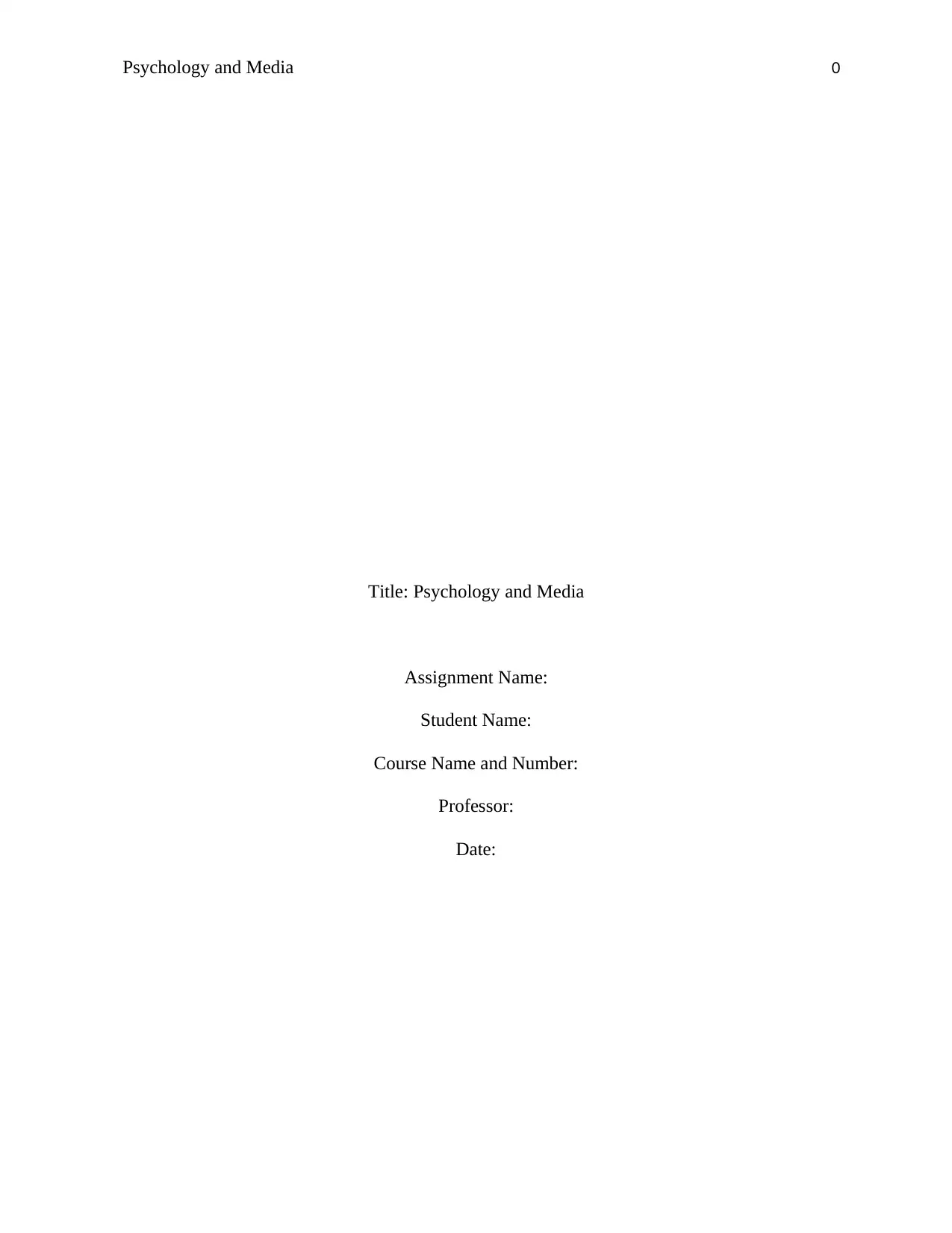
Psychology and Media 0
Title: Psychology and Media
Assignment Name:
Student Name:
Course Name and Number:
Professor:
Date:
Title: Psychology and Media
Assignment Name:
Student Name:
Course Name and Number:
Professor:
Date:
Paraphrase This Document
Need a fresh take? Get an instant paraphrase of this document with our AI Paraphraser
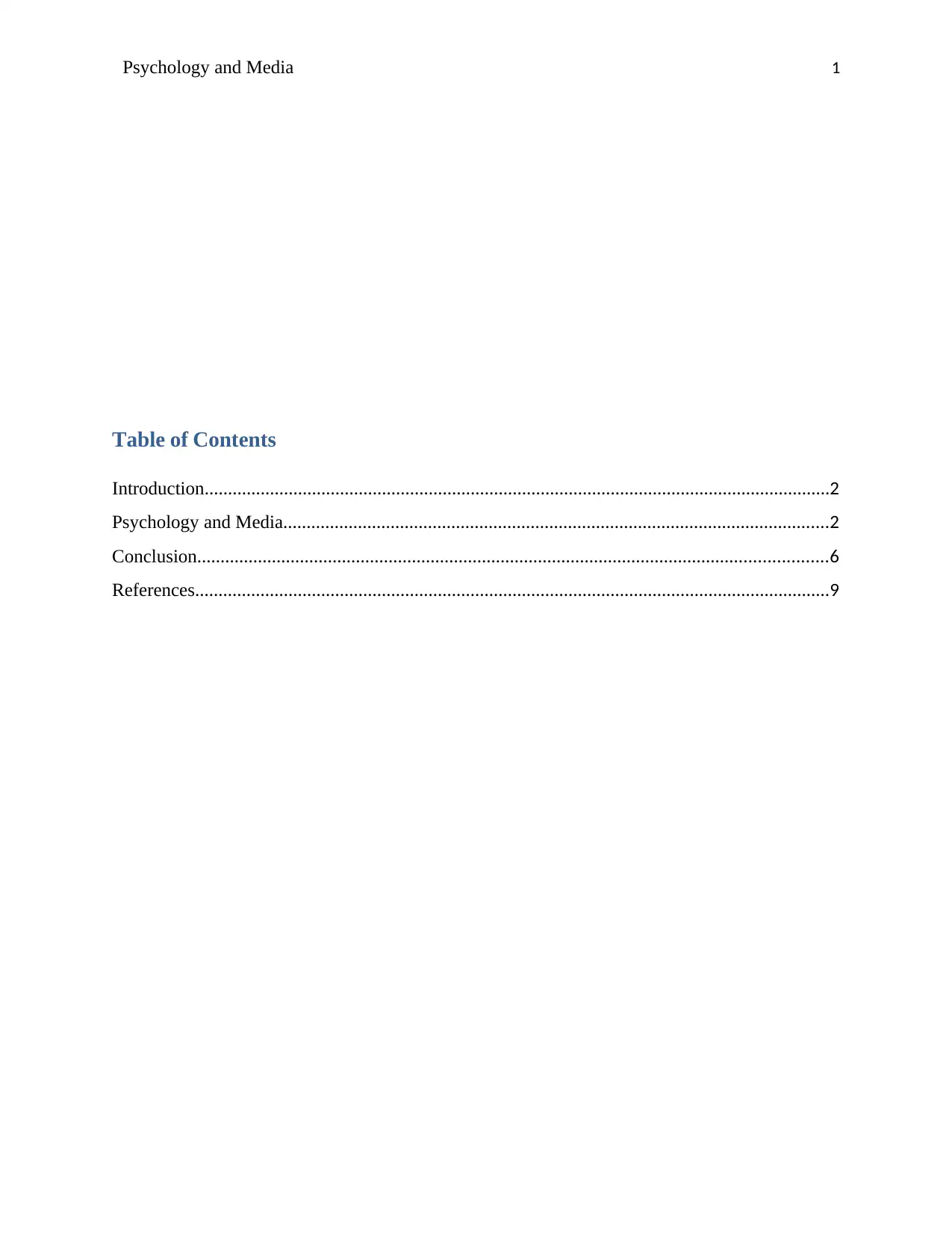
Psychology and Media 1
Table of Contents
Introduction......................................................................................................................................2
Psychology and Media.....................................................................................................................2
Conclusion.......................................................................................................................................6
References........................................................................................................................................9
Table of Contents
Introduction......................................................................................................................................2
Psychology and Media.....................................................................................................................2
Conclusion.......................................................................................................................................6
References........................................................................................................................................9
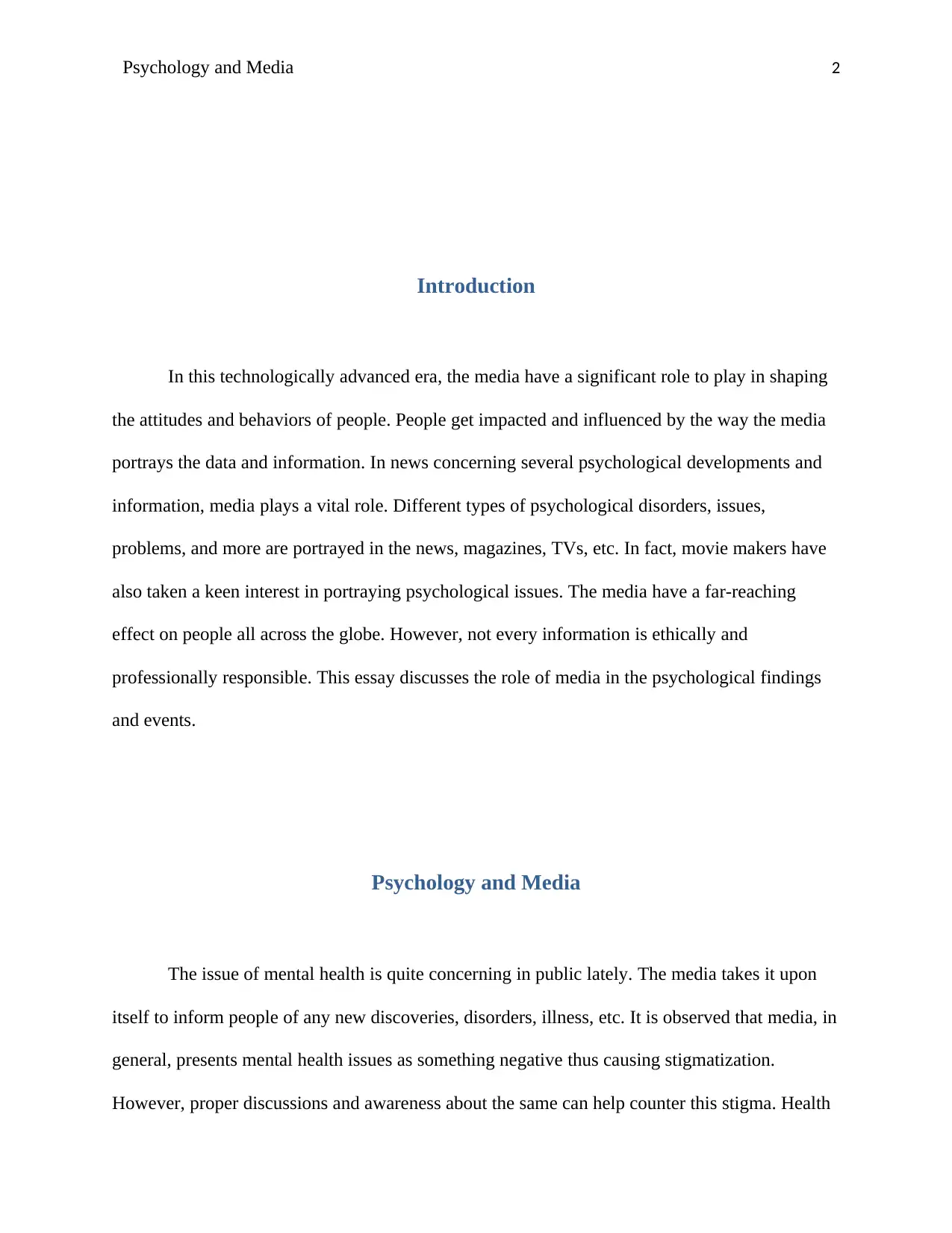
Psychology and Media 2
Introduction
In this technologically advanced era, the media have a significant role to play in shaping
the attitudes and behaviors of people. People get impacted and influenced by the way the media
portrays the data and information. In news concerning several psychological developments and
information, media plays a vital role. Different types of psychological disorders, issues,
problems, and more are portrayed in the news, magazines, TVs, etc. In fact, movie makers have
also taken a keen interest in portraying psychological issues. The media have a far-reaching
effect on people all across the globe. However, not every information is ethically and
professionally responsible. This essay discusses the role of media in the psychological findings
and events.
Psychology and Media
The issue of mental health is quite concerning in public lately. The media takes it upon
itself to inform people of any new discoveries, disorders, illness, etc. It is observed that media, in
general, presents mental health issues as something negative thus causing stigmatization.
However, proper discussions and awareness about the same can help counter this stigma. Health
Introduction
In this technologically advanced era, the media have a significant role to play in shaping
the attitudes and behaviors of people. People get impacted and influenced by the way the media
portrays the data and information. In news concerning several psychological developments and
information, media plays a vital role. Different types of psychological disorders, issues,
problems, and more are portrayed in the news, magazines, TVs, etc. In fact, movie makers have
also taken a keen interest in portraying psychological issues. The media have a far-reaching
effect on people all across the globe. However, not every information is ethically and
professionally responsible. This essay discusses the role of media in the psychological findings
and events.
Psychology and Media
The issue of mental health is quite concerning in public lately. The media takes it upon
itself to inform people of any new discoveries, disorders, illness, etc. It is observed that media, in
general, presents mental health issues as something negative thus causing stigmatization.
However, proper discussions and awareness about the same can help counter this stigma. Health
⊘ This is a preview!⊘
Do you want full access?
Subscribe today to unlock all pages.

Trusted by 1+ million students worldwide
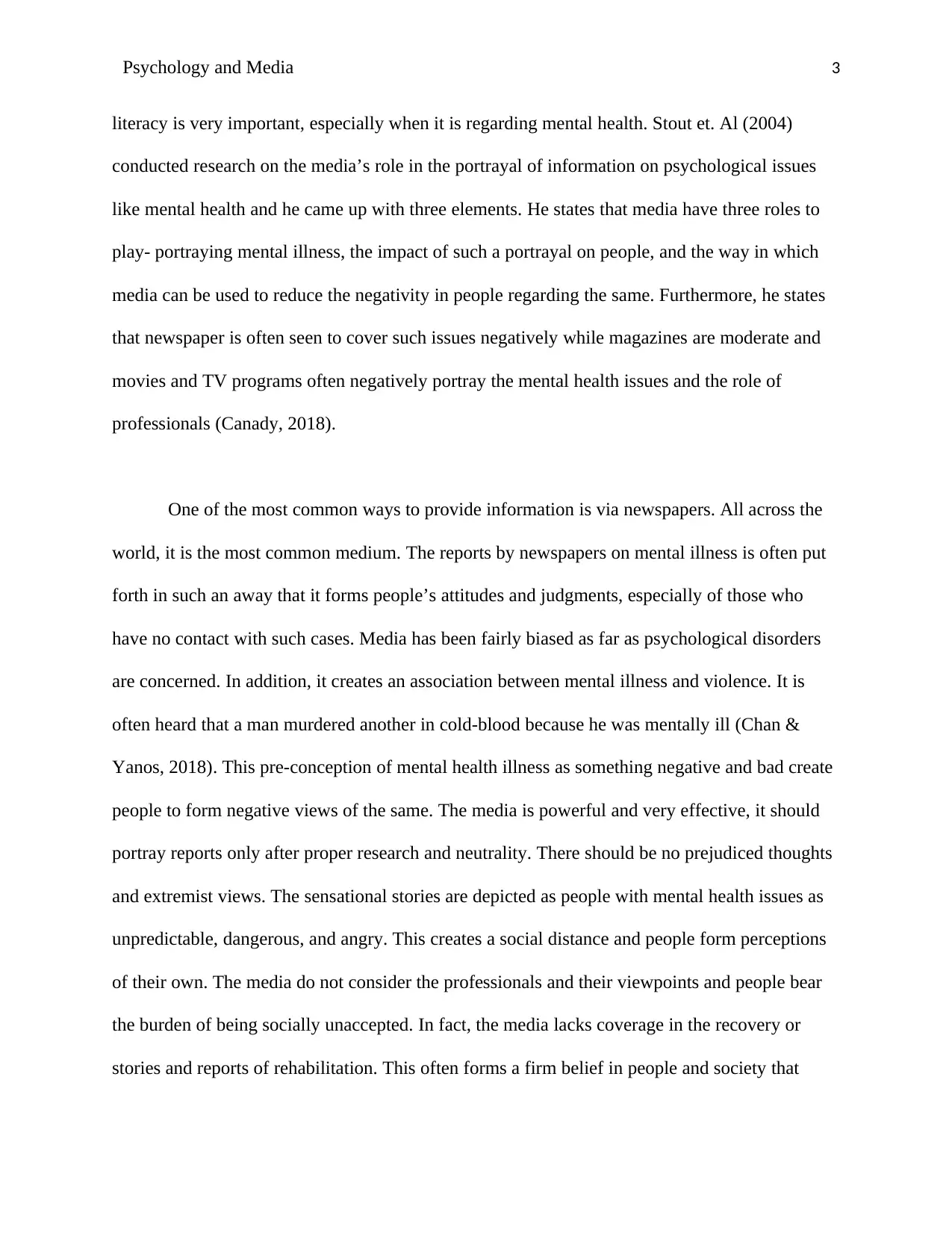
Psychology and Media 3
literacy is very important, especially when it is regarding mental health. Stout et. Al (2004)
conducted research on the media’s role in the portrayal of information on psychological issues
like mental health and he came up with three elements. He states that media have three roles to
play- portraying mental illness, the impact of such a portrayal on people, and the way in which
media can be used to reduce the negativity in people regarding the same. Furthermore, he states
that newspaper is often seen to cover such issues negatively while magazines are moderate and
movies and TV programs often negatively portray the mental health issues and the role of
professionals (Canady, 2018).
One of the most common ways to provide information is via newspapers. All across the
world, it is the most common medium. The reports by newspapers on mental illness is often put
forth in such an away that it forms people’s attitudes and judgments, especially of those who
have no contact with such cases. Media has been fairly biased as far as psychological disorders
are concerned. In addition, it creates an association between mental illness and violence. It is
often heard that a man murdered another in cold-blood because he was mentally ill (Chan &
Yanos, 2018). This pre-conception of mental health illness as something negative and bad create
people to form negative views of the same. The media is powerful and very effective, it should
portray reports only after proper research and neutrality. There should be no prejudiced thoughts
and extremist views. The sensational stories are depicted as people with mental health issues as
unpredictable, dangerous, and angry. This creates a social distance and people form perceptions
of their own. The media do not consider the professionals and their viewpoints and people bear
the burden of being socially unaccepted. In fact, the media lacks coverage in the recovery or
stories and reports of rehabilitation. This often forms a firm belief in people and society that
literacy is very important, especially when it is regarding mental health. Stout et. Al (2004)
conducted research on the media’s role in the portrayal of information on psychological issues
like mental health and he came up with three elements. He states that media have three roles to
play- portraying mental illness, the impact of such a portrayal on people, and the way in which
media can be used to reduce the negativity in people regarding the same. Furthermore, he states
that newspaper is often seen to cover such issues negatively while magazines are moderate and
movies and TV programs often negatively portray the mental health issues and the role of
professionals (Canady, 2018).
One of the most common ways to provide information is via newspapers. All across the
world, it is the most common medium. The reports by newspapers on mental illness is often put
forth in such an away that it forms people’s attitudes and judgments, especially of those who
have no contact with such cases. Media has been fairly biased as far as psychological disorders
are concerned. In addition, it creates an association between mental illness and violence. It is
often heard that a man murdered another in cold-blood because he was mentally ill (Chan &
Yanos, 2018). This pre-conception of mental health illness as something negative and bad create
people to form negative views of the same. The media is powerful and very effective, it should
portray reports only after proper research and neutrality. There should be no prejudiced thoughts
and extremist views. The sensational stories are depicted as people with mental health issues as
unpredictable, dangerous, and angry. This creates a social distance and people form perceptions
of their own. The media do not consider the professionals and their viewpoints and people bear
the burden of being socially unaccepted. In fact, the media lacks coverage in the recovery or
stories and reports of rehabilitation. This often forms a firm belief in people and society that
Paraphrase This Document
Need a fresh take? Get an instant paraphrase of this document with our AI Paraphraser
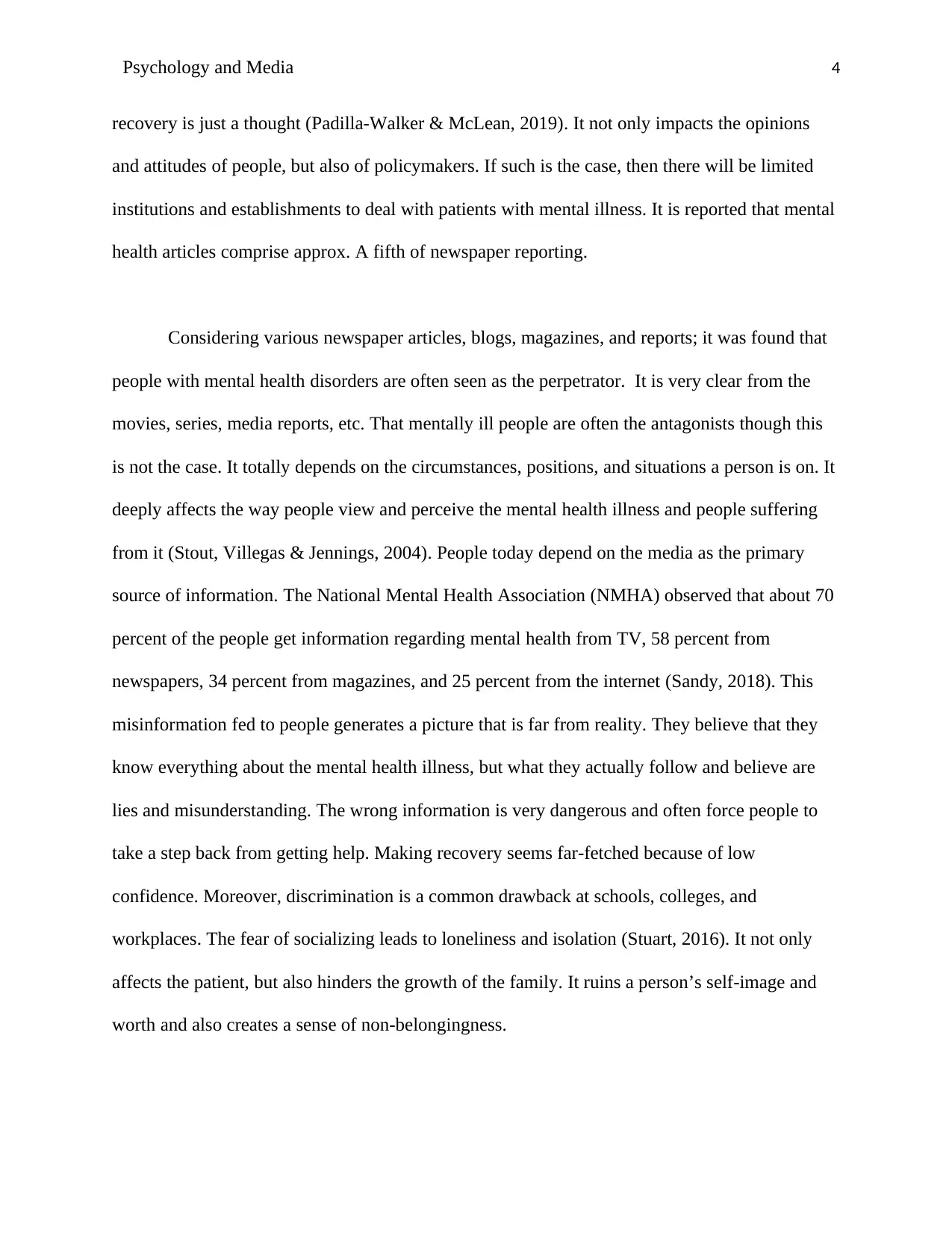
Psychology and Media 4
recovery is just a thought (Padilla-Walker & McLean, 2019). It not only impacts the opinions
and attitudes of people, but also of policymakers. If such is the case, then there will be limited
institutions and establishments to deal with patients with mental illness. It is reported that mental
health articles comprise approx. A fifth of newspaper reporting.
Considering various newspaper articles, blogs, magazines, and reports; it was found that
people with mental health disorders are often seen as the perpetrator. It is very clear from the
movies, series, media reports, etc. That mentally ill people are often the antagonists though this
is not the case. It totally depends on the circumstances, positions, and situations a person is on. It
deeply affects the way people view and perceive the mental health illness and people suffering
from it (Stout, Villegas & Jennings, 2004). People today depend on the media as the primary
source of information. The National Mental Health Association (NMHA) observed that about 70
percent of the people get information regarding mental health from TV, 58 percent from
newspapers, 34 percent from magazines, and 25 percent from the internet (Sandy, 2018). This
misinformation fed to people generates a picture that is far from reality. They believe that they
know everything about the mental health illness, but what they actually follow and believe are
lies and misunderstanding. The wrong information is very dangerous and often force people to
take a step back from getting help. Making recovery seems far-fetched because of low
confidence. Moreover, discrimination is a common drawback at schools, colleges, and
workplaces. The fear of socializing leads to loneliness and isolation (Stuart, 2016). It not only
affects the patient, but also hinders the growth of the family. It ruins a person’s self-image and
worth and also creates a sense of non-belongingness.
recovery is just a thought (Padilla-Walker & McLean, 2019). It not only impacts the opinions
and attitudes of people, but also of policymakers. If such is the case, then there will be limited
institutions and establishments to deal with patients with mental illness. It is reported that mental
health articles comprise approx. A fifth of newspaper reporting.
Considering various newspaper articles, blogs, magazines, and reports; it was found that
people with mental health disorders are often seen as the perpetrator. It is very clear from the
movies, series, media reports, etc. That mentally ill people are often the antagonists though this
is not the case. It totally depends on the circumstances, positions, and situations a person is on. It
deeply affects the way people view and perceive the mental health illness and people suffering
from it (Stout, Villegas & Jennings, 2004). People today depend on the media as the primary
source of information. The National Mental Health Association (NMHA) observed that about 70
percent of the people get information regarding mental health from TV, 58 percent from
newspapers, 34 percent from magazines, and 25 percent from the internet (Sandy, 2018). This
misinformation fed to people generates a picture that is far from reality. They believe that they
know everything about the mental health illness, but what they actually follow and believe are
lies and misunderstanding. The wrong information is very dangerous and often force people to
take a step back from getting help. Making recovery seems far-fetched because of low
confidence. Moreover, discrimination is a common drawback at schools, colleges, and
workplaces. The fear of socializing leads to loneliness and isolation (Stuart, 2016). It not only
affects the patient, but also hinders the growth of the family. It ruins a person’s self-image and
worth and also creates a sense of non-belongingness.
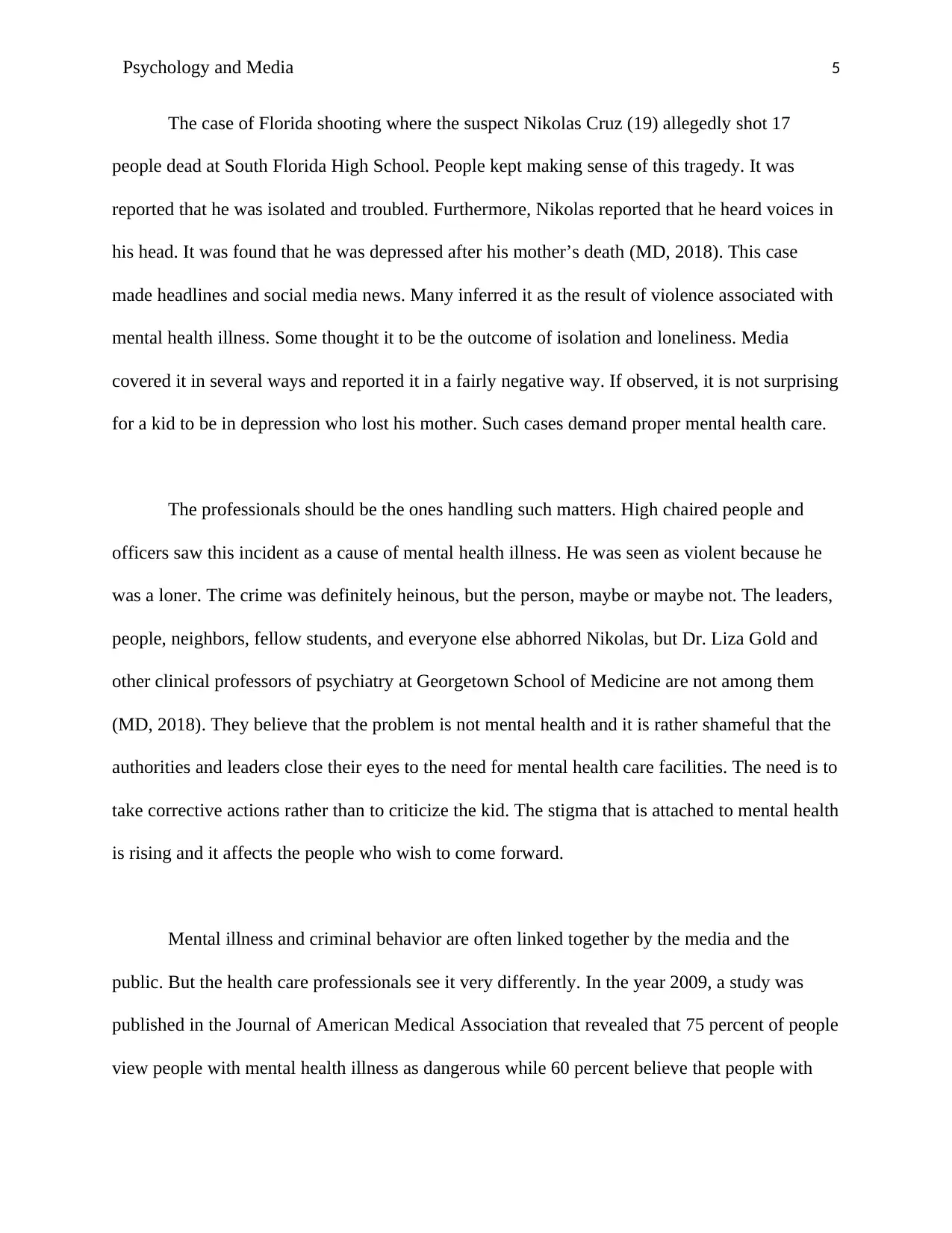
Psychology and Media 5
The case of Florida shooting where the suspect Nikolas Cruz (19) allegedly shot 17
people dead at South Florida High School. People kept making sense of this tragedy. It was
reported that he was isolated and troubled. Furthermore, Nikolas reported that he heard voices in
his head. It was found that he was depressed after his mother’s death (MD, 2018). This case
made headlines and social media news. Many inferred it as the result of violence associated with
mental health illness. Some thought it to be the outcome of isolation and loneliness. Media
covered it in several ways and reported it in a fairly negative way. If observed, it is not surprising
for a kid to be in depression who lost his mother. Such cases demand proper mental health care.
The professionals should be the ones handling such matters. High chaired people and
officers saw this incident as a cause of mental health illness. He was seen as violent because he
was a loner. The crime was definitely heinous, but the person, maybe or maybe not. The leaders,
people, neighbors, fellow students, and everyone else abhorred Nikolas, but Dr. Liza Gold and
other clinical professors of psychiatry at Georgetown School of Medicine are not among them
(MD, 2018). They believe that the problem is not mental health and it is rather shameful that the
authorities and leaders close their eyes to the need for mental health care facilities. The need is to
take corrective actions rather than to criticize the kid. The stigma that is attached to mental health
is rising and it affects the people who wish to come forward.
Mental illness and criminal behavior are often linked together by the media and the
public. But the health care professionals see it very differently. In the year 2009, a study was
published in the Journal of American Medical Association that revealed that 75 percent of people
view people with mental health illness as dangerous while 60 percent believe that people with
The case of Florida shooting where the suspect Nikolas Cruz (19) allegedly shot 17
people dead at South Florida High School. People kept making sense of this tragedy. It was
reported that he was isolated and troubled. Furthermore, Nikolas reported that he heard voices in
his head. It was found that he was depressed after his mother’s death (MD, 2018). This case
made headlines and social media news. Many inferred it as the result of violence associated with
mental health illness. Some thought it to be the outcome of isolation and loneliness. Media
covered it in several ways and reported it in a fairly negative way. If observed, it is not surprising
for a kid to be in depression who lost his mother. Such cases demand proper mental health care.
The professionals should be the ones handling such matters. High chaired people and
officers saw this incident as a cause of mental health illness. He was seen as violent because he
was a loner. The crime was definitely heinous, but the person, maybe or maybe not. The leaders,
people, neighbors, fellow students, and everyone else abhorred Nikolas, but Dr. Liza Gold and
other clinical professors of psychiatry at Georgetown School of Medicine are not among them
(MD, 2018). They believe that the problem is not mental health and it is rather shameful that the
authorities and leaders close their eyes to the need for mental health care facilities. The need is to
take corrective actions rather than to criticize the kid. The stigma that is attached to mental health
is rising and it affects the people who wish to come forward.
Mental illness and criminal behavior are often linked together by the media and the
public. But the health care professionals see it very differently. In the year 2009, a study was
published in the Journal of American Medical Association that revealed that 75 percent of people
view people with mental health illness as dangerous while 60 percent believe that people with
⊘ This is a preview!⊘
Do you want full access?
Subscribe today to unlock all pages.

Trusted by 1+ million students worldwide
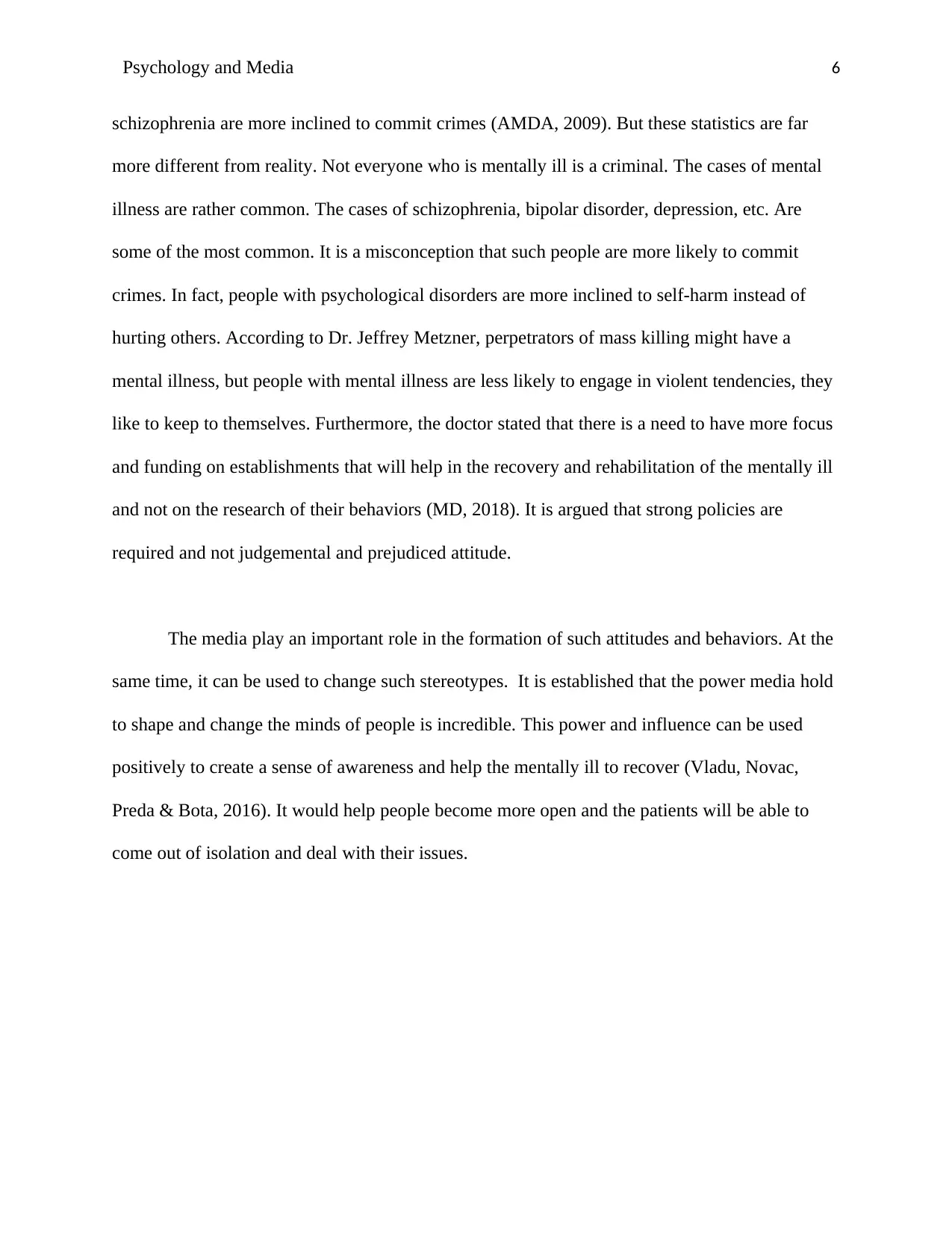
Psychology and Media 6
schizophrenia are more inclined to commit crimes (AMDA, 2009). But these statistics are far
more different from reality. Not everyone who is mentally ill is a criminal. The cases of mental
illness are rather common. The cases of schizophrenia, bipolar disorder, depression, etc. Are
some of the most common. It is a misconception that such people are more likely to commit
crimes. In fact, people with psychological disorders are more inclined to self-harm instead of
hurting others. According to Dr. Jeffrey Metzner, perpetrators of mass killing might have a
mental illness, but people with mental illness are less likely to engage in violent tendencies, they
like to keep to themselves. Furthermore, the doctor stated that there is a need to have more focus
and funding on establishments that will help in the recovery and rehabilitation of the mentally ill
and not on the research of their behaviors (MD, 2018). It is argued that strong policies are
required and not judgemental and prejudiced attitude.
The media play an important role in the formation of such attitudes and behaviors. At the
same time, it can be used to change such stereotypes. It is established that the power media hold
to shape and change the minds of people is incredible. This power and influence can be used
positively to create a sense of awareness and help the mentally ill to recover (Vladu, Novac,
Preda & Bota, 2016). It would help people become more open and the patients will be able to
come out of isolation and deal with their issues.
schizophrenia are more inclined to commit crimes (AMDA, 2009). But these statistics are far
more different from reality. Not everyone who is mentally ill is a criminal. The cases of mental
illness are rather common. The cases of schizophrenia, bipolar disorder, depression, etc. Are
some of the most common. It is a misconception that such people are more likely to commit
crimes. In fact, people with psychological disorders are more inclined to self-harm instead of
hurting others. According to Dr. Jeffrey Metzner, perpetrators of mass killing might have a
mental illness, but people with mental illness are less likely to engage in violent tendencies, they
like to keep to themselves. Furthermore, the doctor stated that there is a need to have more focus
and funding on establishments that will help in the recovery and rehabilitation of the mentally ill
and not on the research of their behaviors (MD, 2018). It is argued that strong policies are
required and not judgemental and prejudiced attitude.
The media play an important role in the formation of such attitudes and behaviors. At the
same time, it can be used to change such stereotypes. It is established that the power media hold
to shape and change the minds of people is incredible. This power and influence can be used
positively to create a sense of awareness and help the mentally ill to recover (Vladu, Novac,
Preda & Bota, 2016). It would help people become more open and the patients will be able to
come out of isolation and deal with their issues.
Paraphrase This Document
Need a fresh take? Get an instant paraphrase of this document with our AI Paraphraser
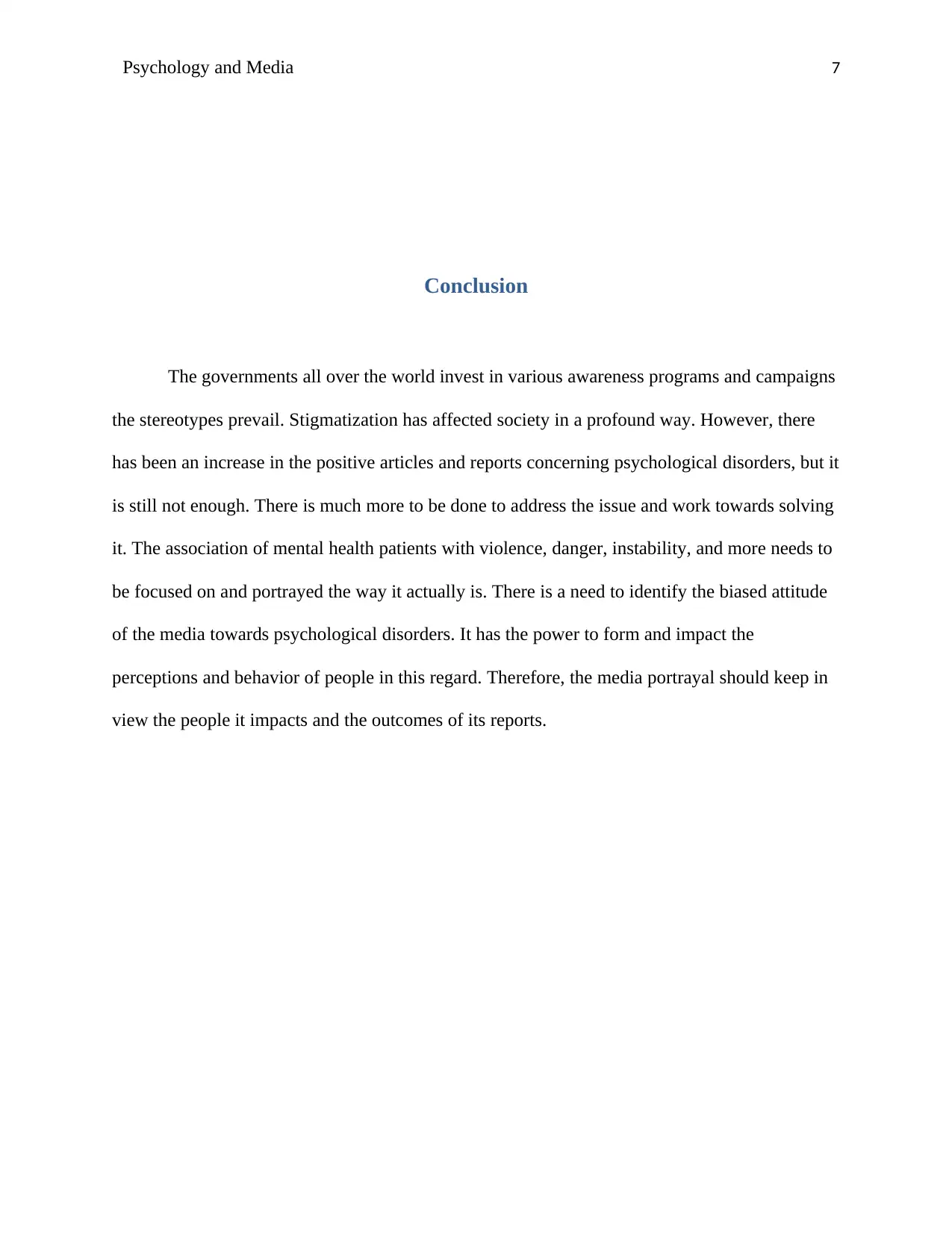
Psychology and Media 7
Conclusion
The governments all over the world invest in various awareness programs and campaigns
the stereotypes prevail. Stigmatization has affected society in a profound way. However, there
has been an increase in the positive articles and reports concerning psychological disorders, but it
is still not enough. There is much more to be done to address the issue and work towards solving
it. The association of mental health patients with violence, danger, instability, and more needs to
be focused on and portrayed the way it actually is. There is a need to identify the biased attitude
of the media towards psychological disorders. It has the power to form and impact the
perceptions and behavior of people in this regard. Therefore, the media portrayal should keep in
view the people it impacts and the outcomes of its reports.
Conclusion
The governments all over the world invest in various awareness programs and campaigns
the stereotypes prevail. Stigmatization has affected society in a profound way. However, there
has been an increase in the positive articles and reports concerning psychological disorders, but it
is still not enough. There is much more to be done to address the issue and work towards solving
it. The association of mental health patients with violence, danger, instability, and more needs to
be focused on and portrayed the way it actually is. There is a need to identify the biased attitude
of the media towards psychological disorders. It has the power to form and impact the
perceptions and behavior of people in this regard. Therefore, the media portrayal should keep in
view the people it impacts and the outcomes of its reports.

Psychology and Media 8
⊘ This is a preview!⊘
Do you want full access?
Subscribe today to unlock all pages.

Trusted by 1+ million students worldwide
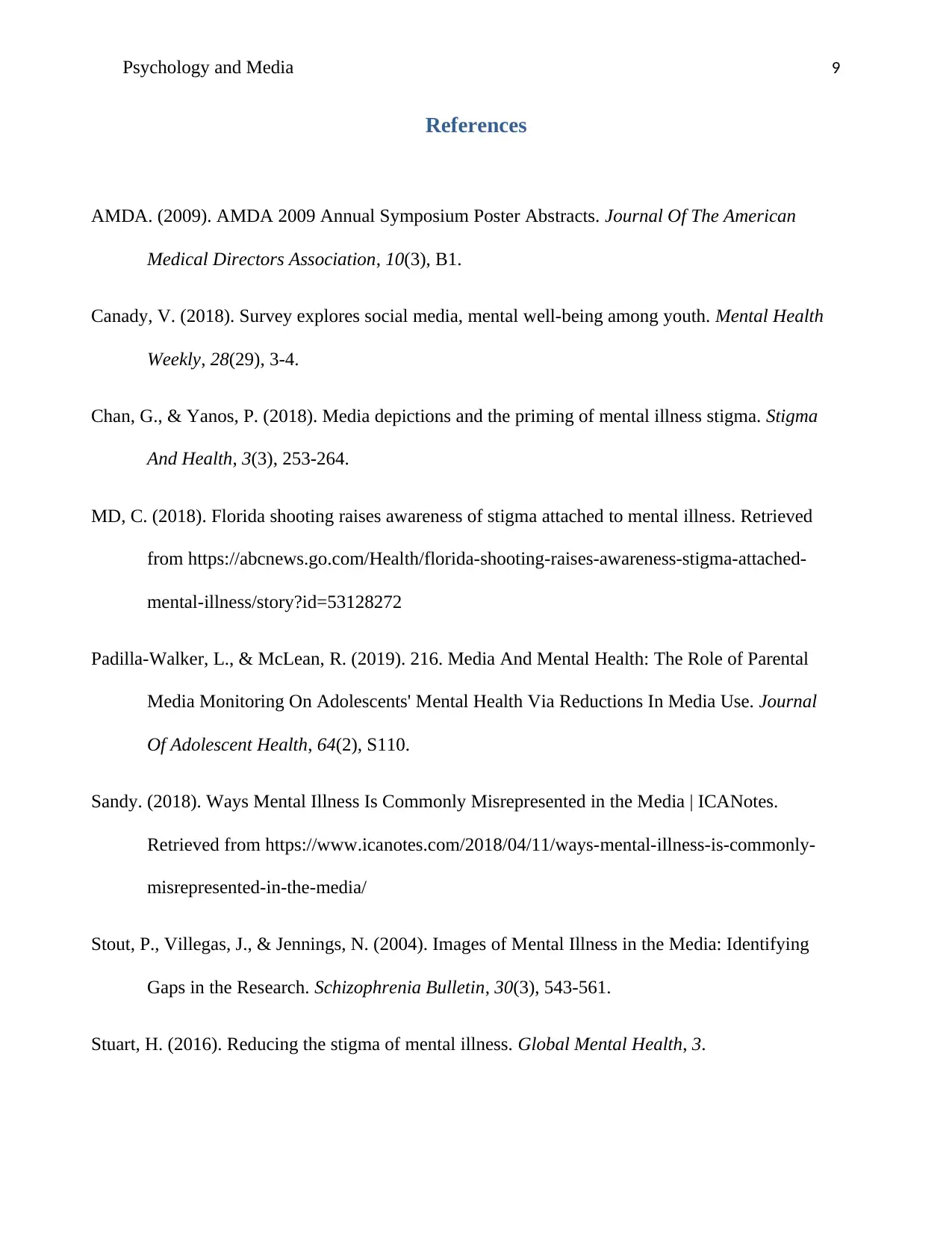
Psychology and Media 9
References
AMDA. (2009). AMDA 2009 Annual Symposium Poster Abstracts. Journal Of The American
Medical Directors Association, 10(3), B1.
Canady, V. (2018). Survey explores social media, mental well-being among youth. Mental Health
Weekly, 28(29), 3-4.
Chan, G., & Yanos, P. (2018). Media depictions and the priming of mental illness stigma. Stigma
And Health, 3(3), 253-264.
MD, C. (2018). Florida shooting raises awareness of stigma attached to mental illness. Retrieved
from https://abcnews.go.com/Health/florida-shooting-raises-awareness-stigma-attached-
mental-illness/story?id=53128272
Padilla-Walker, L., & McLean, R. (2019). 216. Media And Mental Health: The Role of Parental
Media Monitoring On Adolescents' Mental Health Via Reductions In Media Use. Journal
Of Adolescent Health, 64(2), S110.
Sandy. (2018). Ways Mental Illness Is Commonly Misrepresented in the Media | ICANotes.
Retrieved from https://www.icanotes.com/2018/04/11/ways-mental-illness-is-commonly-
misrepresented-in-the-media/
Stout, P., Villegas, J., & Jennings, N. (2004). Images of Mental Illness in the Media: Identifying
Gaps in the Research. Schizophrenia Bulletin, 30(3), 543-561.
Stuart, H. (2016). Reducing the stigma of mental illness. Global Mental Health, 3.
References
AMDA. (2009). AMDA 2009 Annual Symposium Poster Abstracts. Journal Of The American
Medical Directors Association, 10(3), B1.
Canady, V. (2018). Survey explores social media, mental well-being among youth. Mental Health
Weekly, 28(29), 3-4.
Chan, G., & Yanos, P. (2018). Media depictions and the priming of mental illness stigma. Stigma
And Health, 3(3), 253-264.
MD, C. (2018). Florida shooting raises awareness of stigma attached to mental illness. Retrieved
from https://abcnews.go.com/Health/florida-shooting-raises-awareness-stigma-attached-
mental-illness/story?id=53128272
Padilla-Walker, L., & McLean, R. (2019). 216. Media And Mental Health: The Role of Parental
Media Monitoring On Adolescents' Mental Health Via Reductions In Media Use. Journal
Of Adolescent Health, 64(2), S110.
Sandy. (2018). Ways Mental Illness Is Commonly Misrepresented in the Media | ICANotes.
Retrieved from https://www.icanotes.com/2018/04/11/ways-mental-illness-is-commonly-
misrepresented-in-the-media/
Stout, P., Villegas, J., & Jennings, N. (2004). Images of Mental Illness in the Media: Identifying
Gaps in the Research. Schizophrenia Bulletin, 30(3), 543-561.
Stuart, H. (2016). Reducing the stigma of mental illness. Global Mental Health, 3.
Paraphrase This Document
Need a fresh take? Get an instant paraphrase of this document with our AI Paraphraser

Psychology and Media 10
Vladu, C., Novac, A., Preda, A., & Bota, R. (2016). No health without mental health. Mental
Illness, 8(2).
Vladu, C., Novac, A., Preda, A., & Bota, R. (2016). No health without mental health. Mental
Illness, 8(2).
1 out of 11
Related Documents
Your All-in-One AI-Powered Toolkit for Academic Success.
+13062052269
info@desklib.com
Available 24*7 on WhatsApp / Email
![[object Object]](/_next/static/media/star-bottom.7253800d.svg)
Unlock your academic potential
Copyright © 2020–2025 A2Z Services. All Rights Reserved. Developed and managed by ZUCOL.




